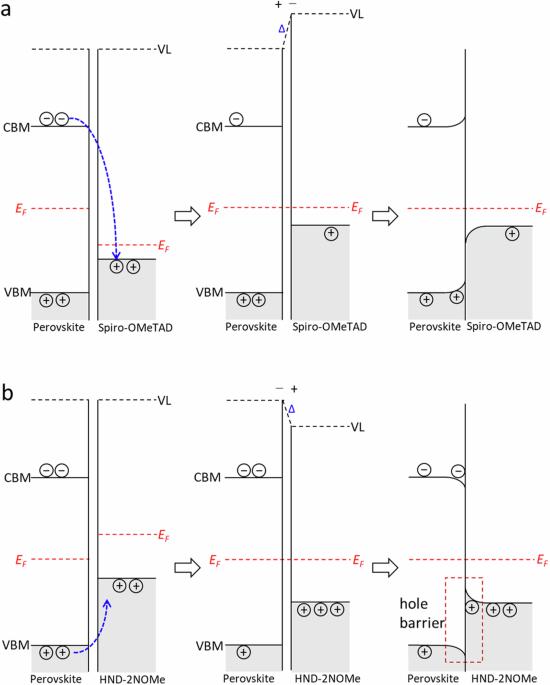Microscopic analysis of low but stable perovskite solar cell device performance using electron spin resonance
IF 9.6
Q1 MATERIALS SCIENCE, MULTIDISCIPLINARY
引用次数: 0
Abstract
Perovskite solar cells have attracted much attention as next-generation solar cells. However, a typical hole-transport material, spiro-OMeTAD, has associated difficulties including tedious synthesis and high cost. To overcome these shortcomings, an easily synthesized and low-cost hole-transport material has been developed: HND-2NOMe. Although HND-2NOMe has high local charge mobility because of the quasi-planar structure, its lower device performance is a weak point, the cause of which has not yet been clarified. Here, we analyse the source of the lower performance by clarifying the internal states from a microscopic viewpoint using electron spin resonance. We observe hole diffusion from perovskite to HND-2NOMe under dark conditions, indicating hole barrier formation at the perovskite/HND-2NOMe interface, leading to lower performance. Although such a barrier is formed, less hole accumulation for the HND-2NOMe-based cells under solar irradiation occurs, which is related to the stable performance. The sources of the lower but stable performance are crucially important for providing guidelines for improving the device performance. Hole-transport materials possessing high charge mobility are important in perovskite solar cells but the source of lower performance remains a mystery. Here, the microscopic mechanism for low but stable perovskite solar cell performance using these materials is analysed using electron spin resonance.

利用电子自旋共振对低性能但稳定的过氧化物太阳能电池装置进行微观分析
作为下一代太阳能电池,过氧化物太阳能电池备受关注。然而,一种典型的空穴传输材料--螺-OMeTAD--存在合成繁琐、成本高昂等问题。为了克服这些缺点,我们开发了一种易于合成且成本低廉的空穴传输材料:HND-2NOMe 。虽然 HND-2NOMe 因其准平面结构而具有较高的局部电荷迁移率,但其较低的器件性能却是一个薄弱环节,其原因尚未明确。在这里,我们利用电子自旋共振从微观角度阐明了内部状态,从而分析了性能较低的原因。在黑暗条件下,我们观察到空穴从包晶石向 HND-2NOMe 扩散,这表明在包晶石/HND-2NOMe 界面形成了空穴势垒,从而导致性能降低。虽然形成了这种势垒,但基于 HND-2NOMe 的电池在太阳照射下的空穴积累较少,这与性能稳定有关。性能较低但稳定的原因对于为提高器件性能提供指导至关重要。具有高电荷迁移率的空穴传输材料在过氧化物太阳能电池中非常重要,但性能降低的原因仍是一个谜。在此,我们利用电子自旋共振分析了使用这些材料的过氧化物太阳能电池性能低但稳定的微观机制。
本文章由计算机程序翻译,如有差异,请以英文原文为准。
求助全文
约1分钟内获得全文
求助全文
来源期刊

Communications Materials
MATERIALS SCIENCE, MULTIDISCIPLINARY-
CiteScore
12.10
自引率
1.30%
发文量
85
审稿时长
17 weeks
期刊介绍:
Communications Materials, a selective open access journal within Nature Portfolio, is dedicated to publishing top-tier research, reviews, and commentary across all facets of materials science. The journal showcases significant advancements in specialized research areas, encompassing both fundamental and applied studies. Serving as an open access option for materials sciences, Communications Materials applies less stringent criteria for impact and significance compared to Nature-branded journals, including Nature Communications.
 求助内容:
求助内容: 应助结果提醒方式:
应助结果提醒方式:


